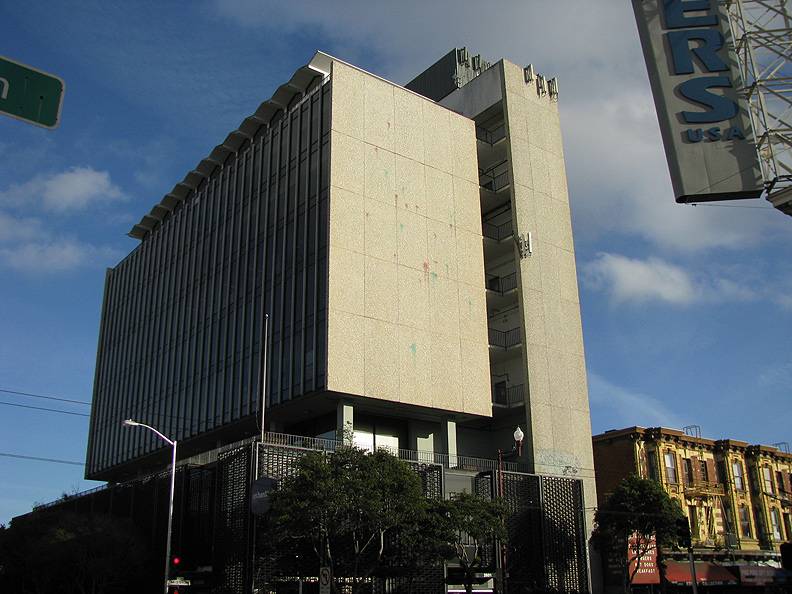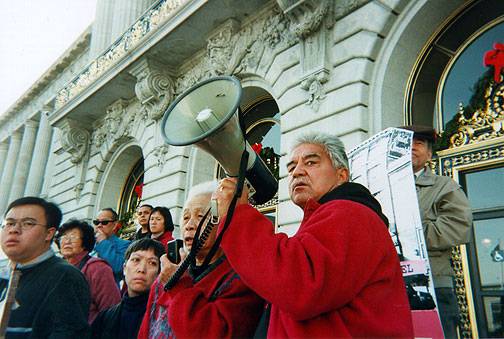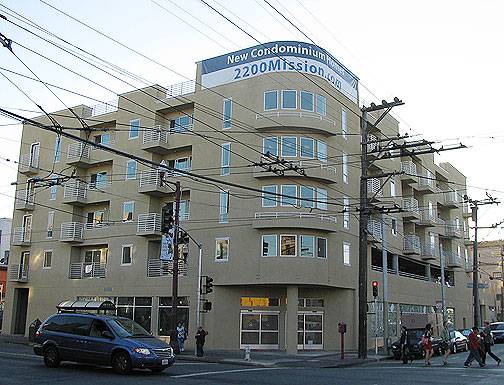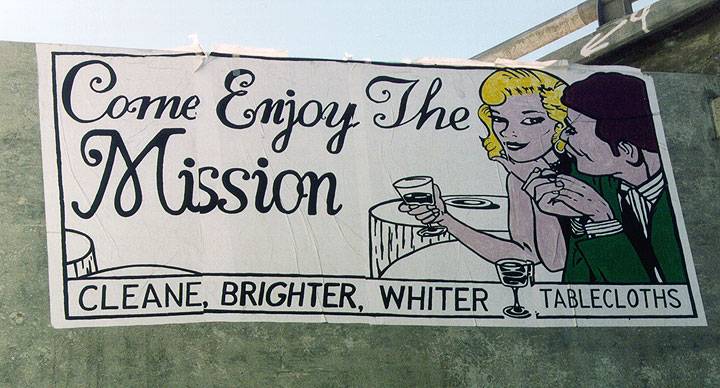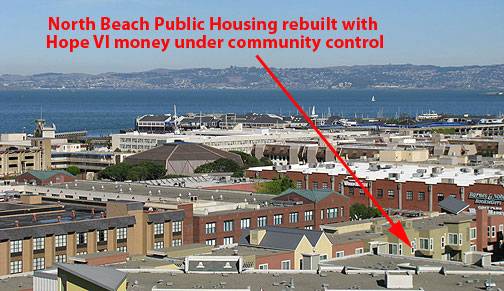A Decade of Displacement
Historical Essay
by James Tracy
San Francisco’s Hidden Housing History
The housing crisis doesn’t exist because the system isn’t working. It exists because that’s the way the system works.
The former Bayview Bank building at 22nd and Mission. Small paint splotches are still visible on its wall in this 2007 photo, originally slingshotted up by housing activists occupying the intersection of 22nd and Mission and the former Dance Mission space on the southwest corner in 2000 during prolonged Dotcom protests.
Photo: Chris Carlsson
Whether fleeing from a death squad in Latin America or a homophobic family in the Midwest, many have sought refuge here. Those who consider San Francisco an “island,” offer ample evidence: the sizable protest culture, gay marriages, and the municipal minimum wage. Certainly we live in a beautiful city, worth fighting for. However, cold, hard reality demands that we acknowledge the ways that San Francisco is nearly identical to every other city in the nation.
Segregation? Here? Maybe not apartheid or “separate but equal” but let’s just say that here two people can walk down the same street and experience it in completely different ways. One person can look at Valencia Street and wonder where the best crêpes are, the other can wonder if she can make it to the bus stop without being stopped by the police.
Consider the depths of a decade of displacement: nearly 17,353 formal, “no-fault” evictions filed with the Rent Arbitration and Stabilization Board. Ted Gullicksen of the San Francisco Tenants Union estimates that this number is doubled if all those who moved at the mere threat of eviction are considered. These estimates don’t cover evictions as a consequence of simply not being able to make the high rent: on the average 5,000 evictions a year. The grand total hovers around 90,000 evictions for the years from 1990 to 2000. This number does not even include housing lost in government-subsidized buildings, immigrants who leave when threatened with a visit from La Migra, or residential hotels lost to suspicious fires. The eviction wave was intensified, of course, by the dot.com boom (1997–2000), but persists to this day.
Thanks to decades of economic assault, “racial cleansing” initiatives such as urban renewal/removal, African Americans make up about 15% of the city’s overall population but nearly half of the clients in the emergency homeless shelter system.
The 1990s also saw the high profile police murders of people of color, notably Mark Garcia, Aaron Williams, and Sheila Detoy. In most cases, those responsible suffered little consequence and families were confronted with absolute indifference from San Francisco’s liberal political establishment. Far from the image of a progressive island, from this vantage point, San Francisco continues a long love affair with the venerable Jim Crow.
The electorate is hypocritical when it comes to class-consciousness. While consistently defending rent control and bucking the national rightward trend, the same voters have an appetite for persecution of the poor. Voters overwhelmingly approved gutting general assistance checks; even though recipients were forced into workfare to “earn” those “benefits.” It is now possible to clean a city bus, fold towels at General Hospital, or do “alternative” workfare at a nonprofit for $1.81 an hour! The same voters also outlawed panhandling in the subsequent election. Support for anti-poor legislation was so broad that many a “progressive” voter also supported near-slave labor. Our Left shuts down the streets in protest of war but notable corporate war profiteers, such as Bechtel, still find our island hospitable enough to call home.
Nevertheless, every step of the way there has been pitched resistance, some of it quite effective, to attempts to rebuild San Francisco in corporate America’s image. The city’s potential dissident populations have never gone out without a fight. The concerted effort to displace, segregate, and discipline these groups out of existence has never been entirely successful. Toward this end everyday people have turned to a variety of tactics, both at the ballot box and the barricades.
The Hidden History of the 1990s
Some observers have commented that it seemed as if San Franciscans took the nineties’ displacement assault lying down, that no real fight back occurred until the end of the decade. In fact, everyday San Franciscans led a variety of campaigns confronting evictions, exclusion, and the criminalization of homeless people.
The case of 83-year-old Lola McKay became a symbol of the eviction madness and helped to galvanize political opposition to displacement. McKay’s home of forty years was bought by the John Hickey brokerage. Hoping to sell each of the four units in the building separately, the firm moved to evict her (homes delivered vacant to new buyers increase in value). With virtually no support network or family, McKay vowed to fight to the end for the right to live in her home.
A loose collection of groups including the San Francisco Tenants Union and the Senior Housing Action Collaborative began a campaign with only one demand: a lifetime lease for McKay. Although it would have been easy to grant this, and still make an enormous profit on the three vacant units, the brokerage did not relent until activists occupied the offices of their lawyers, Weigel and Freed. Television coverage shifted between McKay and a protest that resulted in a broken window and an altercation with a security guard. The occupation took sympathetic attention away from “first- time homeowners” fulfilling the American Dream, and exposed corporations that wouldn’t think twice about evicting your grandmother.
“Lola McKay’s case stood for seniors who have to fight for their rights in this city, and unfortunately Lola died for these rights. Her case ripped the mask off of the evictors and revealed them to be property speculators, not just small property owners trying to exercise their property rights,” explained Barbara Blong of the Senior Action Network.
The McKay actions were simply the most visible of many spirited protests and “landlord visits” pulled off by tenant activists in the 1990s. Other actions shut down landlords’ places of business, such as when the owner of a flower shop attempted to evict a person in the latter stages of AIDS. At one protest a 92-year-old woman who had spent time in the French Resistance against Nazi occupation declared “I have shot fascists dead in the streets of Europe so I will not let a petty landlord drive me from my home.”
Long-time San Francisco radical Bill Sorro at an anti-eviction rally on City Hall steps, c. 1999.
Photo: Chris Carlsson
On another front, the Mission Agenda, a poor people’s organization, was on the frontlines in another key housing battle. Throughout the latter part of the 1990s suspicious fires swept through residential hotels, destroying several hundred units of housing. Residential hotels often provide the last line of defense against homelessness. Many speculated that the fires were set by slumlords, but it was impossible to prove. The Agenda worked directly with fire survivors, often meeting people in makeshift shelters. Typically the city, along with the Red Cross, would offer limited relief and relocation assistance in the form of a small rental voucher.
After forming a new tenants union, the residents and the Agenda aggressively confronted public officials every time a batch of housing vouchers expired. This forced the city to extend the subsidy until permanent replacement housing was found for each tenant. The organization coordinated with caseworkers to make sure that services were also provided. Many people avoided homelessness by refusing to settle for crumbs. The relocation campaigns made anger visible at slum conditions within the hotels. As a consequence, the Board of Supervisors passed long-overdue legislation mandating sprinklers in residential hotels, outlawing the practice of extracting bribes for guests, and increased city attorney attention to the already illegal practice of evicting hotel tenants after a twenty-eight-day stay in order to prevent them from gaining rights as residents.
Taken together, such in-your-face tactics were extremely effective at beating back specific evictions, yet failed to provide a sustained and focused counter-attack against evictions and displacement. Tenants also went to the ballot to strengthen rent control four times during the 1990s, with half the victories diluted or defeated by a pro-landlord Superior Court.
Dot Colonization and Resistance
If San Francisco’s heart still beats, it is despite the “new money” that arrived during the 1990s. The fabled boom-time economy, fueled by the dot.com explosion, cannibalized the housing stock and the last blue-collar jobs. During this boom, one of San Francisco’s oldest neighborhoods, the predominantly Latino Mission district, bore the brunt of the eviction frenzy.
The Mission Anti-Displacement Coalition (MAC), a collection of groups such as People Organized to Demand Environmental and Economic Rights (PODER), the Mission Agenda, St. Peter’s Housing Committee, the Day Laborers Program, and Mission Housing and Development Corporation formed the core of the new grouping. Each organization had done respect-able community organizing separately—defending the rights of residential hotel tenants, fighting immigrant discrimination, and evictions, or building low-income housing. MAC represented a more coordinated, broader attempt to work together toward a different vision of the city.
MAC recognized that the fight was on all fronts. Direct action against specific targets (for example, a developer of unaffordable housing) was part of the tactical arsenal. MAC could also turn out hundreds of people for planning commission meetings. As nonenforcement of city regulations monopolized much of the available land for luxury condominiums, unequal development became the focus. MAC’s demands were:
• An immediate moratorium on new market-rate housing and live-work lofts in the Mission. • An immediate moratorium on office conversions and new construction of dot.com office space in the Mission. • An immediate end to all illegal conversions. • A community planning process to rezone the Mission District.
The coalition grew in the wake of an apparent corporate takeover of the gentrification process. After the Mayor Brown–controlled Board of Supervisors approved the Bryant Square project, a gigantic office development in the middle of the Mission, residents mobilized in unprecedented numbers. The Southern California–based Stein Kingsley Stein Corporation pushed for approval even though it was acknowledged that planting such a development in the middle of a residential neighborhood would fuel displacement.
A community “accountability session,” with planning department director Gerald Green produced a surprising 500 angry attendees. MAC launched an energetic year of direct actions aimed at exposing the Planning Commission’s complicity in displacement. One time MAC occupied Bigstep.com, a company that displaced dozens of community-service agencies when it moved into the Bayview Building (purchased by the Cort family). Outside, a community dialogue on displacement was ignited through a banner-hanging event while bilingual agitators passed out flyers for the next MAC meeting.
Condominiums at 18th and Mission Streets, 2008.
Photo: Chris Carlsson
On numerous other occasions, planning commission meetings were stacked, and many times shut down altogether. A “caminata” procession throughout the neighborhood attracted over a thousand people. While the Lola McKay actions had helped to put a human face on displacement, MAC took the debate a step further as a collective movement willing to work both within and outside the formal legislative system.
The San Francisco Print Collective’s partnership with MAC set a wonderful standard for how artists can make themselves useful during times of political strife. While many other groups of artists spoke up only when their own art spaces were threatened with eviction, the SFPC collaborated with MAC to create awesome silkscreened anti-gentrification posters promoting the struggles of the neighborhood’s working classes. One poster in particular summed up the conflict, the slogan “They Plan for Profits, We Plan for People,” over a picture of everyday neighborhood folks.
San Francisco Print Collective hung this on the freeway over Valencia during the dot-com boom in 1999 that was overrunning the neighborhood during the time.
Photo: Chris Carlsson
“MAC had an impact because it meant that the Mission District community attempted to take control over its own destiny around critical issues such as housing and community planning. MAC created an optimism that you could fight and win,” remarked Renee Saucedo, executive director of the San Francisco Day Laborers program, “Also, it was significant that immigrant day laborers, some of the most excluded members of society, participated.” Contestation also erupted at the ballot box. Inspired by the return of district-based elections, neighborhood groups fielded independent candidates to directly challenge the Board of Supervisors members installed by Mayor Brown. Of the eight candidates endorsed by MAC, seven were victorious, winning on platforms that were explicitly anti-displacement. One MAC coalition founder, Chris Daly, took District 6 (which included part of the Mission) by a landslide. Matt Gonzalez, a public defender and poetry patron easily won the Haight and Western Addition after switching party affiliation from Democrat to Green in midstream. Proposition L, which encapsulated the spirit of MAC’s demands, was defeated thanks to a large infusion of corporate cash and a decoy measure, Proposition K, placed on the ballot by Mayor Brown.
After the progressive sweep, participation in MAC dipped dramatically. Many individuals held the mistaken impression that with electoral success, the housing crisis would simply be taken care of. Years later, rents are still extremely high and evictions common.
Antonio Diaz of PODER summed up the MAC experience. “When we were talking in the late nineties about the dot.com boom, it became obvious that the single-issue groups had to come together. Fighting gentrification wasn’t going to be a short-term campaign. It would mean effective organizing, mass mobilizations, and more. MAC brought together groups that were already doing work and created a force that could counteract the displacement push.” Still, even with significant gains Diaz knows that there is still much to be done. “Since the dot.com bust MAC has been trying to dig deep into our constituencies. In the beginning we needed to make a swift impact. Now we’re making sure that we pay attention to bringing in new activists and doing popular education. I think that if we had incorporated more of this in the beginning we would have made more of a change.”
Keeping the Public in Public Housing
Public housing often serves as the last line of defense against homelessness for low-income workers. Neither resident or neighbor would argue that these ancient developments didn’t need rehabilitation. San Francisco became ground zero in the battle against another wave of urban removal, through the federal HOPE VI program. The program is ostensibly progressive, demolishing and rehabilitating dilapidated buildings. But the program also reduces the quantity of housing. The first two projects to be rebuilt were reconstructed with fewer dwellings. Many residents were not able to return due to a labyrinth of new federal regulations designed to make sure that public housing wasn’t so public anymore. Add to the mix the local partnership with private developers (well connected to Mayor Brown) and you have a recipe for disaster.
The residents of North Beach Public Housing (NBPH) weren’t about to let their community be destroyed by the wrecking ball. Many of them had come to live in subsidized housing after having their neighborhoods and homes demolished thirty years prior in the so-called “Urban Renewal” push. Residents went through a complicated process of resident meetings, street protests, petition drives, and legal action in partnership with the Eviction Defense Network (EDN) before coming upon the trump card: voting with one’s butt.
Residents found their strategic advantage: the San Francisco Housing Authority (SFHA) might have had to return over $20 million to the federal government if residents did not move quickly. This meant that it would be risky for the agency to second-guess the residents’ willingness to engage in civil disobedience by refusing to move, or by putting up legal obstacles. The residents demanded cooperative ownership of the development, revitalized through a community process. When they got nowhere, they refocused on other bread-and-butter issues. Their ten-point-program spelled out one-for-one replacement, the right to return, and various safeguards designed to make sure the development was rebuilt swiftly and that residents were not disqualified for technicalities.
Photo: Chris Carlsson
Another simple tactic helped build tenant unity. Many issues between Chinese and Black tenants were settled by simply recruiting translators. Also, tenants who faced evictions were protected by the advocacy work of the EDN, helping to build a willingness to stay in the larger fight.
The residents morphed their program into a contract. Soon, nearly the entire development signed cards stating their refusal to relocate unless the contract was signed. Orange signs simply demanded “Sign the Contract!” in English, Chinese, and Spanish. Faced with the prospects of a protracted fight, resulting in the loss of funding, the agency relented, and signed the contract.
Today, the development is nearly reconstructed according to the demands of the residents. The residents stayed organized, even from their temporary homes, and all signs point to a successful reoccupancy. Today, the SFHA doesn’t even talk about “revitalizing” a development without stepping to the table with the guarantees won by the North Beach residents.
Homelessness and the Civil Disobedience of Everyday Life
Forget what you might have been told about homelessness. Ronald Reagan didn’t cause the homelessness epidemic by de-institutionalizing mentally ill people. Homelessness is linked to two main causes—the economy and the destruction of the social safety net. Mental illness, addiction, veteran’s status, and domestic violence intensify the homelessness cycle for many. Homelessness expands when living-wage jobs are replaced by service-sector ones, when welfare-to-work programs lead to no work or low-wage work without child care.
In step with the rest of the nation, San Francisco, through five administrations, has been stuck in an endless rut of policing the “visible” homeless population. The cycle goes something like this: business people begin to complain loudly about homeless people, then a torrent of “exposés” come out in the media blaming tolerance for the presence of people on the street. Soon after, laws prohibiting “Quality of Life Crimes” (read: sleeping or panhandling) are proposed by a mayor or mayoral candidate.
This is invariably accompanied by massive police sweeps, incarceration, and ticketing of homeless people. For those sleeping on the streets, sleeping is an act of civil disobedience. During this time, groups such as Homes Not Jails and Religious Witness With Homeless People led high-profile takeovers of vacant housing. Such actions rarely yielded permanent gains but often provided a stark contrast to the media stereotypes. As a result, homeless people were portrayed repairing homes instead of the usual images of drug-addled scam artists.
Our society fetishizes private property, but apparently this fascination does not extend to the personal property of homeless people. The Civil Rights Workgroup of the Coalition on Homelessness has recorded numerous incidents between police officers and un-housed person that would be hilarious if it weren’t right out of Catch-22.
In this scene an officer points to a shopping cart filled with bundles of clothes and other items. He asks, “Are these things yours?” If the answer is “yes,” then the property is confiscated and a citation issued. If “no,” then the property is confiscated anyhow.
When historians start to write the biography of Big Brother, they may very well conclude that he started his political career in a homeless shelter. Those using emergency shelters must be fingerprinted, as all single adult welfare recipients have had to be since 1993, under Mayor Frank Jordan. In 1997 Mayor Brown borrowed a helicopter, equipped with infrared night vision, to identify homeless encampments in Golden Gate Park.
Now many thousands of tickets later, homeless people are more visible than ever, yet there seems to be no end in sight to the scapegoating. Homeless people did not take the assault on their sleep lying down. Police sweeps have triggered numerous sleep-ins at the homes of public officials. “Camp Agnos” occupied City Hall plaza as a protest against the push to expel visibly poor people from the central city during Art Agnos’s mayoralty (1987-1991).
As a supervisor, our current mayor Newsom added a slick new tool to the mix: his successful Care Not Cash campaign, Proposition N, convinced voters that the way to show caring was to cut general assistance checks down to $59. The campaign promised housing and services in lieu of cash. A report by City Controller Ed Harrington pretty much established that such care was not unlike weapons of mass destruction in Iraq: missing. In addition, homeless people will now pay for the privilege of sleeping on a two-inch thick shelter cot.
The poetic irony is that Care Not Cash not only harnessed both hatred and sympathy but also sounded like Food Not Bombs, the activist group persecuted by Mayor Jordan for its ongoing felony conspiracy to commit lunch.
The campaign gave Newsom a lot of face time in the local media, conveniently circumventing campaign laws. The next election, Newsom, with the backing of the chamber of commerce, convinced voters to outlaw “aggressive” panhandling. In a parallel effort the hotel council began to take out advertisements implying that giving spare change to homeless people would spread sexually transmitted diseases and shut down small businesses. It doesn’t take a degree in health or economics to figure out that STDs are spread by unprotected sex and small businesses sink when the economy does.
When Mayor Newsom, or anyone else for that matter, proposes poor laws, they are simply repeating a bad script first written in England 400 years ago. Is this much different from being sent to the gallows for the crime of begging? Have we come far from the days when an unemployed Londoner could be conscripted into slavery by any willing master? Ask the person making $1.81 an hour cleaning the MUNI bus you rode to work this morning.
Cities and the Future of Community Organizing
Like any other city, San Francisco has a simple choice: inclusion or exclusion? Will our city complete the turn toward a gated community, where citizenship is defined by class status?
Cities often function similarly to factories. They are places where diverse people must live next to each other, take public transportation, and wait in line for the same public services. Like factories of old, this holds potential for community organizing and building unusual alliances. This is not to suggest that workplace organizing should be a thing of the past. On the contrary, this concept merely expands the idea of the labor movement into additional arenas. Wherever market forces take away resources needed for working-people’s survival, there exists a potential for transformative social struggle.
Community organizers can draw another lesson from the history of the labor movement. Turn-of-the-century labor radicals agitated against narrow unions based on trades and for industrial unions. The logic was that if workers in the same industry were in different unions, bosses could easily pit trade against trade. In tenant and community organizing, tenant groups are often hopelessly segregated between subsidized-housing tenants and those living in private apartments. At one tenant convention in the mid-decade, public housing residents were even told by movement “leaders” not to come! As James Baldwin pointed out “If they take you in the morning, they will be coming for us that night.” As public housing was demolished, the ripple effect fueled additional evictions in the surrounding areas.
Effective models of resistance can be many and varied, but probably share the following in common: a willingness to take action, outside of formal electoral and legislative channels, engagement at the ballot box only on strategic terms, nurturing participation from those most excluded from power, and resource sharing.
Our Vision Thing
One should have no illusions that the housing crisis will go away without a radical restructuring of an economy that encourages property speculation and a cultural shift away from the idea of housing as a commodity. Before that day, reforms that combine practical survival with an alternate, community-based vision of urban life, are worth working toward.
The chamber of commerce has plenty of long-term vision. They spawned Proposition J in March 2004 to turn over the entire central city to market-rate housing development, creating a distinct class-segregation pattern, skewering the electorate further rightward. This was done by promising to create “affordable housing” available to households with an annual income of $77,000. Fortunately, San Francisco voters defeated it by a two-to-one ratio.
If the elites have a vision of a city of elites, how best to counter it? Community activists have proven that we can defend many people from evictions, and win at the ballot box occasionally. Despite numerous organizing successes, the gated community expands at the costs of all others. Most of the truly interesting proposals share some characteristics in common: a redefinition of public goods that doesn’t necessarily involve state-owned forms of public ownership, a clear vision of economic uplift rooted in challenging race and class inequities.
Imagine if any of the community struggles described above went beyond their inherent limits and led to a truly mass upheaval of San Franciscans, resolved to not only end the current wave of community displacement but drastically alter the way people relate to land and housing?
In this alternate future, say that in addition to the populist electoral upheaval, a parallel citywide rent strike led to massive renters’ defense, reminiscent of the Unemployed Worker’s Movements of the 1930s. In this future, landlords would not only be picketed, but families un-evicted through collective direct action. In this scenario, eviction courts would be unable to operate as everyday people regularly blockaded the courthouse when eviction cases were heard.
In this future, San Franciscans build the type of power to challenge not only evictions but change the assumptions of housing for profit. An aggressive strategy of housing decommodification could take place.
This would take many forms, including traditional models of nonprofit ownership found in many cities today. However, a key demand would be social housing managed collectively by the residents themselves. In any case, the aim would be to insulate large sections of neighborhoods from the boom-and-bust cycles of the housing economy.
Tired of only acting defensively, many housing activists are working toward a community land trust to provide housing without landlords, therefore without the threat of evictions for profit. Under this model, community members own an interest in the building they live in, but the nonprofit land trust retains stewardship of the land. When a unit is vacated, the resident receives a return, but equity is limited in order to preserve permanent affordability. While residents maintain democratic control, safeguards exist to prevent breaking equity caps and speculation.
Recently in New York, the city turned over dozens of buildings to squatters who had lived in them for years, using a model very similar to the land trust. Advocates see an opportunity to concretize “no displacement” demands made through the organizing process as a way of moving beyond landlording—an outdated holdover from feudalism. Similar approaches could stabilize homesteaded, or squatted, buildings. It should be no surprise that residents of two demolished public housing developments had proposed cooperative ownership of their reconstructed homes.
Such a program should not give governments cover to slash spending on housing and human services, asking residents to manage their own austerity. In an ideal situation, as displacement ended, preserved communities could turn their attention toward building innovative institutions of resistance, and of course, spend a little more time on things that high housing costs steal from us all: creative pursuits and time with each other. By experimenting with forms of cooperative social relationships we can provide a real challenge to the notion that private profits are sacred and that the marketplace is the only way to distribute housing and other vital goods. To paraphrase the turn-of-the-century radical union the Industrial Workers of the World, “building a new world inside the shell of the old.” We can at least get a glimpse.
A city worth living in cannot be won solely at the ballot box or City Hall. It requires a constant push from below, on community, not corporate terms. As San Franciscans confront the next wave of displacement, most likely fueled by demolitions to skirt the rent ordinance or the looming biotech boom, we would do well to remember that entering into a fight for survival without direct action is the same as tying one’s arm behind one’s back.
Despite our losses, the future is still thankfully up for grabs.
published originally in The Political Edge ed. Chris Carlsson (City Lights Foundation: 2004)

